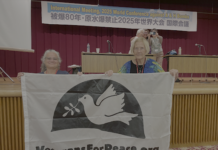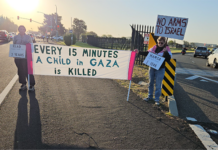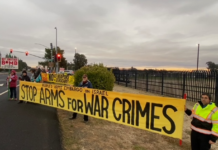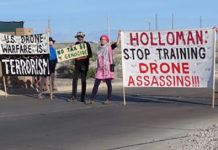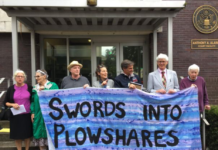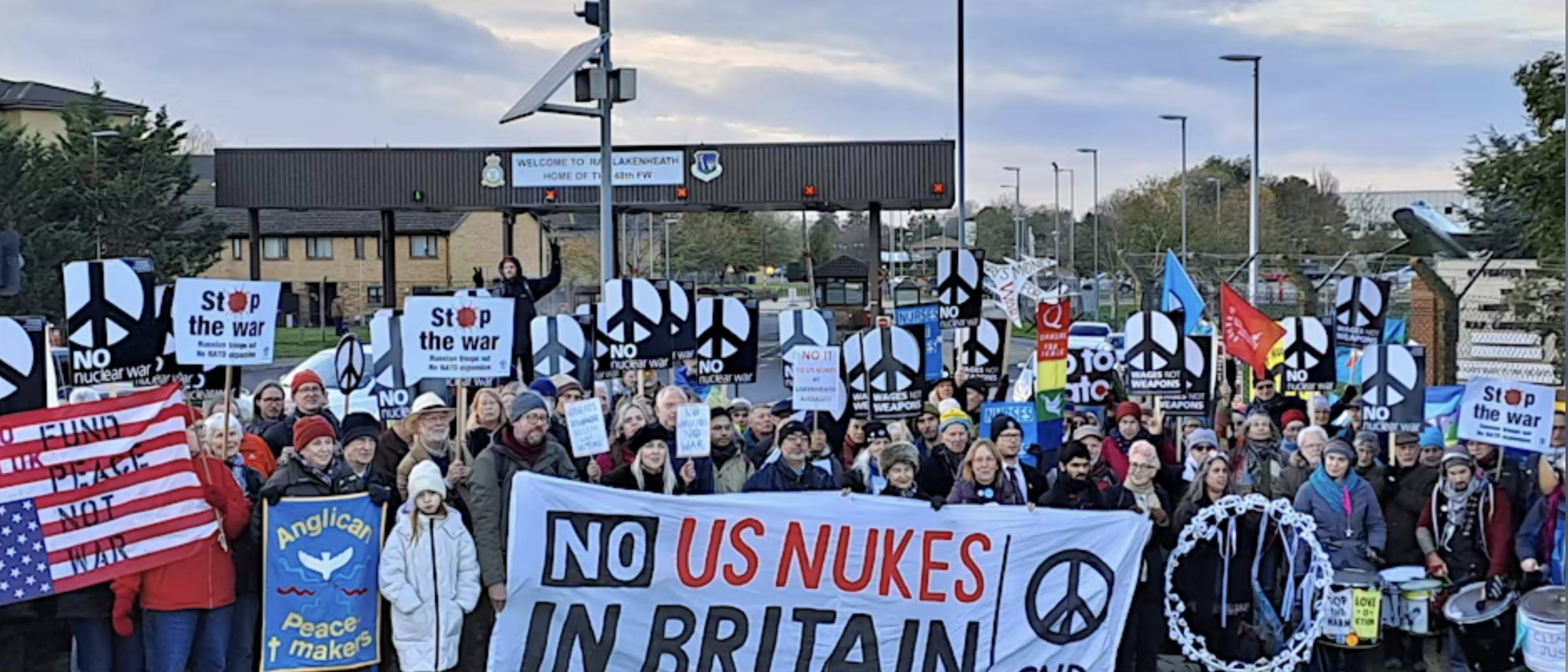
In anticipation of U.S. nuclear weapons returning to UK soil after their removal 18 years ago, activists from around the world gathered at the Lakenheath Peace Camp from April 14 to 25, 2025, with a 24-hour-a-day, 7-day-a-week vigil at the main entrance to the Royal Air Force (RAF) Lakenheath base.
Organized by Lakenheath Alliance for Peace and a coalition of many groups, the 11-day encampment with specific events each day culminated in a peace conference on April 24, 2025, and a blockade of the air base on April 25, 2025.
The peace conference was titled “Analysing and Resisting US Nuclear Expansion” and featured well-known speakers who focused on topics from global militarism to the arms trade, with a detailed focus on the dangers of nuclear weapons.
Preparations for Storage of U.S. Nuclear Weapons Again in the UK
As reported in a March 3, 2025, article in the U.S. military newspaper Stars and Stripes titled “RAF Lakenheath lays groundwork for possible return of US nuclear bomb storage, report says,” the U.S. Air Force has been constructing facilities at RAF Lakenheath for its “surety” program, a program that wil mark the return of nuclear weapons to England.
The article refers to a report written by the American Federation of Scientists (AFS) that, after three years of collection of documentation and observations, they determined that the U.S. Air Force is re-establishing its nuclear mission on United Kingdom soil for the first time in nearly two decades.
AFS researchers Hans M. Kristensen and Eliana Johns have written voluminously about U.S. nuclear weapons in Europe. Much of the information in this article comes from their excellent and extensive research.
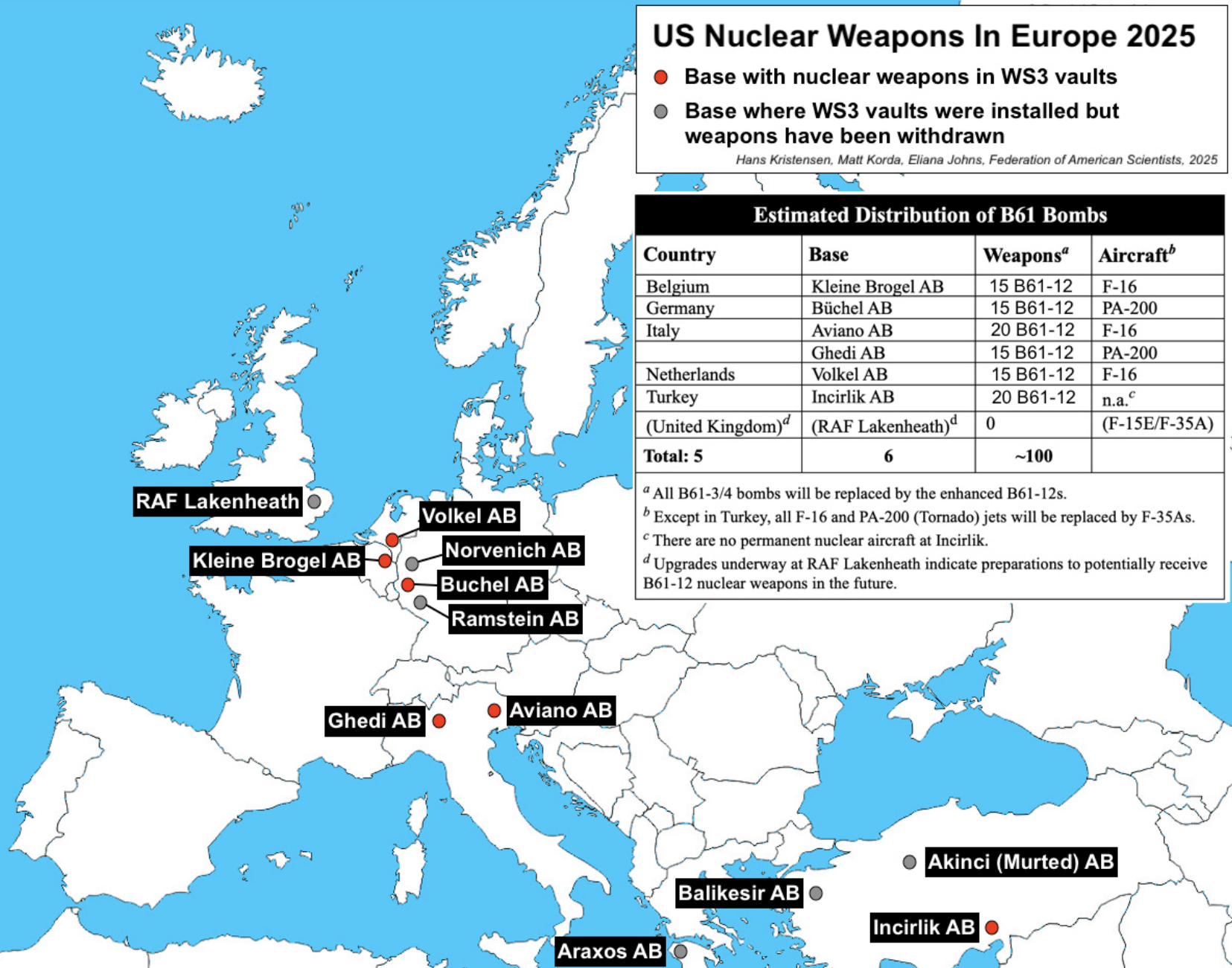
Approximately 100 U.S. B61-12 gravity bombs currently are stored in six air bases in five NATO countries: Aviano and Ghedi in Italy, Incirlik in Türkiye, Kleine Brogel in Belgium, Volkel in Netherlands, and Büchel in Germany.
The AFS report states that “the change appears to be a direct reaction to the worsening political and military relations with Russia, resulting from its invasions in 2014 and 2022 of Ukraine, frequent nuclear warnings, and Russian deployment of increasingly capable long-range conventional weapons.”
The American Federation of Scientists assessment is that, as of February 2025, there are no indications yet that nuclear weapons have been deployed to RAF Lakenheath, and that the return of the nuclear mission to Lakenheath is intended primarily as a backup, rather than to deploy weapons for now.
In 2021, NATO Secretary General Jens Stoltenberg stated: “We have no plans of stationing any nuclear weapons in any other countries than we already have these nuclear weapons as part of our deterrence, and that… have been there for many, many years.” Two years later, in 2023, while the Lakenheath upgrade was well under way, Jessica Cox, then-head of NATO nuclear policy, echoed Stoltenberg’s assurance: “There is no need to change where they are placed.”
RAF Lakenheath to Receive U.S. Nuclear Weapons Stored at Other Locations in Europe
The AFS report states that, once construction at RAF Lakenheath is completed and the base becomes an active nuclear site, it could potentially receive nuclear weapons from other locations in Europe in a crisis or emergency contingency.
Visible upgrades at bases across Europe are also designed to facilitate the rapid movement of weapons between bases to increase operational flexibility and reduce vulnerability to Russia’s increasingly capable long-range conventional missiles.
In the case of a nuclear crisis with Russia, a portion of U.S. nuclear weapons could be redistributed from more vulnerable NATO bases to RAF Lakenheath to improve survivability and complicate Russia’s targeting strategy.
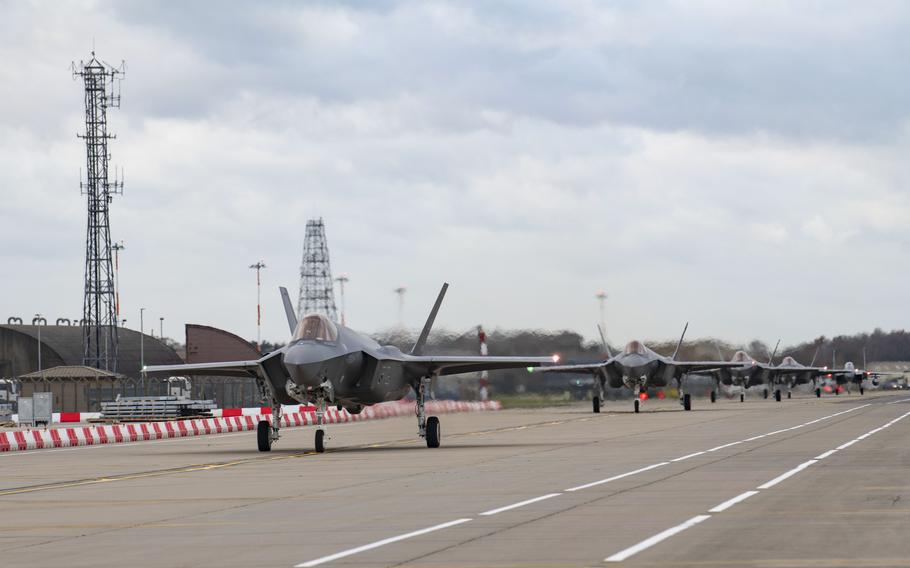
Redistribution of weapons could potentially also be used to signal a willingness to use nuclear weapons during a serious crisis. Changes within NATO itself could also potentially force a redistribution of nuclear weapons.
The AFS report identifies one such potential scenario that occurred in 2016 during the coup attempt in Türkiye, when power to Incirlik Air Base was cut off for nearly a week. U.S. security forces were put on full alert while Turkish President Recep Erdogan accused the head of U.S. Central Command of “taking sides” in the coup.
Another scenario occurred after a clash between Türkiye and the United States over Syria in 2019, during which U.S. agencies reportedly quietly reviewed evacuation plans for the nuclear weapons at Incirlik Air Base.
The number of vaults being reactivated at Lakenheath appears to be similar to the number of active vaults at Incirlik. Satellite images from 2017 and 2019 did show what appeared to be nuclear weapons shipments at Incirlik, but these could have been regular transports or exercises, and there is no public indication that U.S. nuclear weapons have been withdrawn from Incirlik.
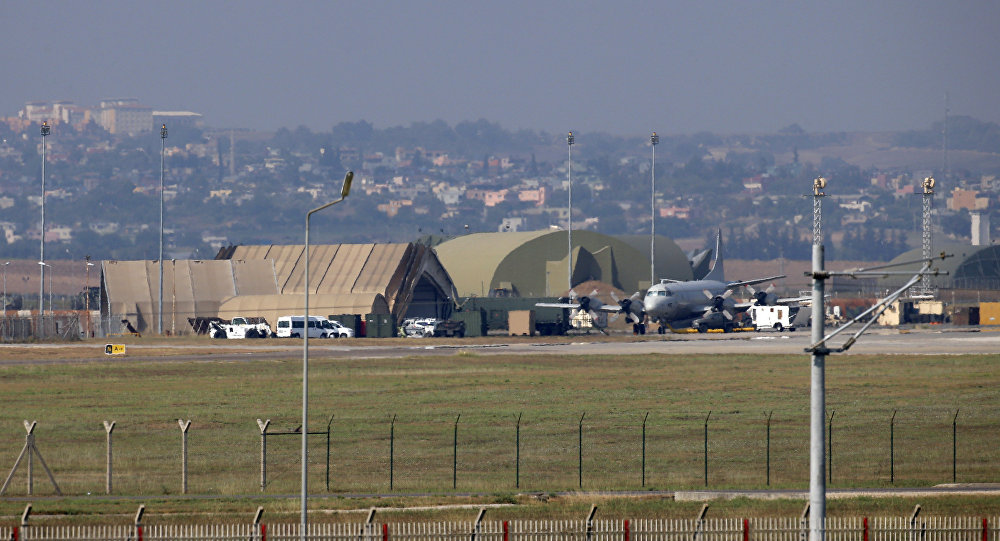
The administrator of the U.S. Department of Energy’s National Nuclear Security Administration, Jill Hruby, in remarks at the Hudson Institute on January 16, 2025, stated that “the B61-12 gravity bombs are fully forward deployed.”
The appoximately 100 U.S. B61-12 gravity bombs are stored in six air bases in five NATO countries—Aviano and Ghedi in Italy, Incirlik in Türkiye, Kleine Brogel in Belgium, Volkel in Netherlands, and Büchel in Germany.
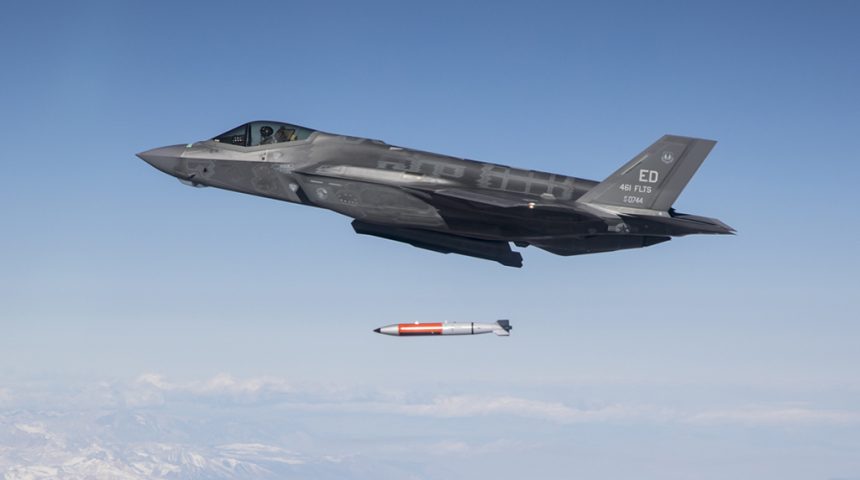
In 2022, RAF Lakenheath became the first European base to receive the F-35A which was technically certified in March 2024 to carry the B61-12 gravity bomb, officially making it a dual-capable aircraft. Aside from Türkiye, each NATO country that hosts U.S. nuclear weapons has purchased the F-35A to replace their nuclear delivery aircraft.
Despite all the preparations, so far, the researchers for the American Federation of Scientists have not seen indications that the B61-12 nuclear bomb has yet been deployed to RAF Lakenheath, an occurrence that would break with decades of policy and planning and reverse the southern focus of the European nuclear deployment that emerged after the end of the Cold War and would likely require consent from the UK prime minister.
History of Nuclear Weapons in the UK
The end of the Cold War brought about significant changes to the postures and force structures of nuclear-armed states. The United States conducted major Base Realignment and Closure (BRAC) activities from 1993 to 1995 that restructured U.S. forces in Europe and resulted in a significant reduction to the number of nuclear weapons in Europe.
While nuclear weapons were still deployed at host country bases, the U.S. Air Force (USAF) consolidated its nuclear operations to four main bases: RAF Lakenheath in England, Ramstein Air Base in Germany, Incirlik Air Base in Türkiye, and Aviano Air Base in Italy.
The U.S. reduction of its non-strategic nuclear arsenal in Europe coincided with the United Kingdom eliminating its own non-strategic nuclear weapons.
Following the lead of the unilateral Presidential Nuclear Initiatives in 1991 and 1992 that withdrew most U.S. and Russian nuclear weapons from Western Europe, the United Kingdom retired its naval non-strategic nuclear weapons and withdrew its last air-delivered gravity bombs from Europe.
By 1998, all British non-strategic nuclear weapons had been scrapped, making the United Kingdom the first nuclear-armed state to reduce its arsenal to a single platform: nuclear-armed ballistic missile submarines.
Meanwhile, the United States continued to deploy and upgrade its own nuclear-capable aircraft and gravity bombs at RAF Lakenheath. By the early 2000s, Lakenheath hosted 110 B61 gravity bombs for delivery by U.S. F-15Es of the 492nd and 494th fighter squadrons of the 48th Fighter Wing.
As FAS researcher Kristensen wrote in 2008, the George W. Bush administration further downsized the U.S. nuclear posture in Europe by reducing the number of nuclear deployment bases and cutting the number of nuclear bombs in half. This included withdrawing all nuclear weapons from RAF Lakenheath, marking the first time since 1954 that there were no U.S. nuclear weapons on U.K. soil.
The F-15Es of the 48th Fighter Wing at Lakenheath continued to participate in nuclear exercises, but the Weapons Storage and Security System vaults at the base were placed in caretaker status. This meant that they would receive basic maintenance but would no longer be nuclear-certified and, therefore, would no longer store nuclear weapons until a decision was made to reactivate the vaults.
Today, RAF Lakenheath is the largest USAF-operated base in the United Kingdom and maintains a significant role in the U.S. military posture in Europe.
In addition to two squadrons of F-15Es, the 48th Fighter Wing at Lakenheath in 2021 became the first wing outside of the United States to operate the F-35A Lightning II and is currently the only USAF wing to operate both F-15E and F-35A nuclear-capable fighters.

CovertAction Magazine is made possible by subscriptions, orders and donations from readers like you.
Blow the Whistle on U.S. Imperialism
Click the whistle and donate
When you donate to CovertAction Magazine, you are supporting investigative journalism. Your contributions go directly to supporting the development, production, editing, and dissemination of the Magazine.
CovertAction Magazine does not receive corporate or government sponsorship. Yet, we hold a steadfast commitment to providing compensation for writers, editorial and technical support. Your support helps facilitate this compensation as well as increase the caliber of this work.
Please make a donation by clicking on the donate logo above and enter the amount and your credit or debit card information.
CovertAction Institute, Inc. (CAI) is a 501(c)(3) non-profit organization and your gift is tax-deductible for federal income purposes. CAI’s tax-exempt ID number is 87-2461683.
We sincerely thank you for your support.
Disclaimer: The contents of this article are the sole responsibility of the author(s). CovertAction Institute, Inc. (CAI), including its Board of Directors (BD), Editorial Board (EB), Advisory Board (AB), staff, volunteers and its projects (including CovertAction Magazine) are not responsible for any inaccurate or incorrect statement in this article. This article also does not necessarily represent the views the BD, the EB, the AB, staff, volunteers, or any members of its projects.
Differing viewpoints: CAM publishes articles with differing viewpoints in an effort to nurture vibrant debate and thoughtful critical analysis. Feel free to comment on the articles in the comment section and/or send your letters to the Editors, which we will publish in the Letters column.
Copyrighted Material: This web site may contain copyrighted material the use of which has not always been specifically authorized by the copyright owner. As a not-for-profit charitable organization incorporated in the State of New York, we are making such material available in an effort to advance the understanding of humanity’s problems and hopefully to help find solutions for those problems. We believe this constitutes a ‘fair use’ of any such copyrighted material as provided for in section 107 of the US Copyright Law. You can read more about ‘fair use’ and US Copyright Law at the Legal Information Institute of Cornell Law School.
Republishing: CovertAction Magazine (CAM) grants permission to cross-post CAM articles on not-for-profit community internet sites as long as the source is acknowledged together with a hyperlink to the original CovertAction Magazine article. Also, kindly let us know at info@CovertActionMagazine.com. For publication of CAM articles in print or other forms including commercial internet sites, contact: info@CovertActionMagazine.com.
By using this site, you agree to these terms above.
About the Author
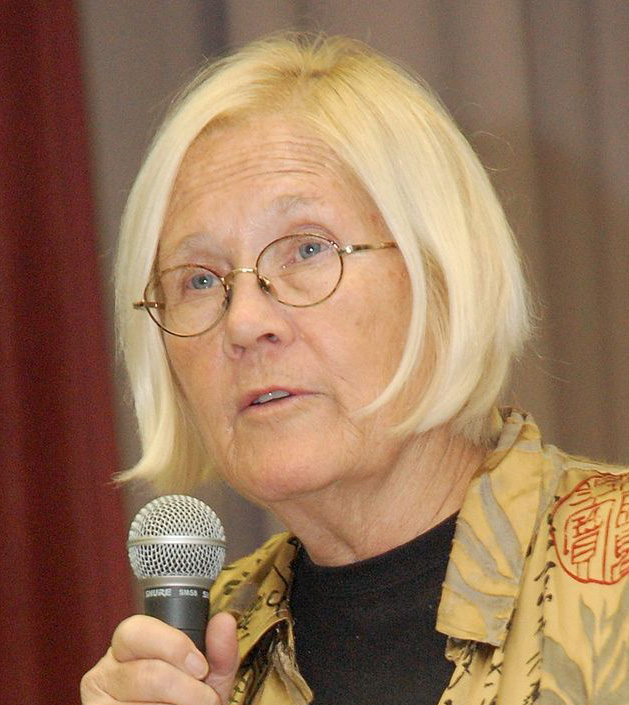
Ann Wright is a retired United States Army colonel and retired U.S. State Department official.
She was one of three State Department officials to publicly resign in direct protest of the 2003 Invasion of Iraq.
Since that time Colonel Wright has been a dedicated peace activist.
Ann can be reached at annw1946@gmail.com.

